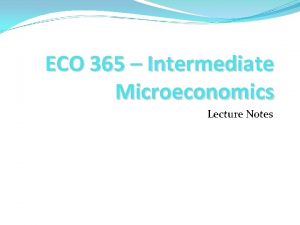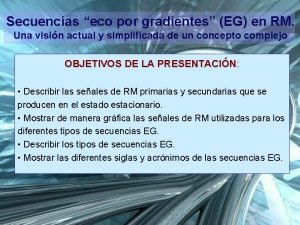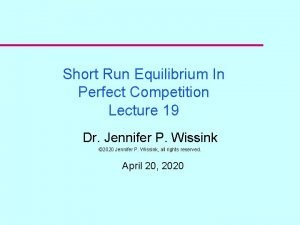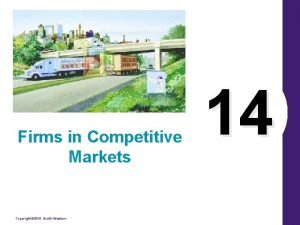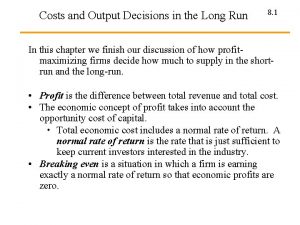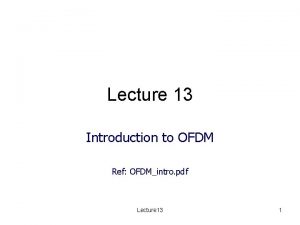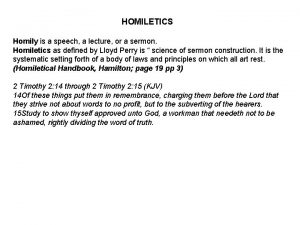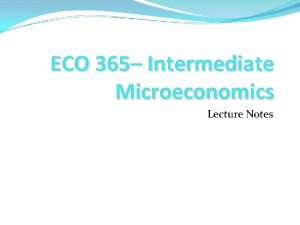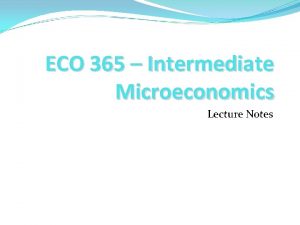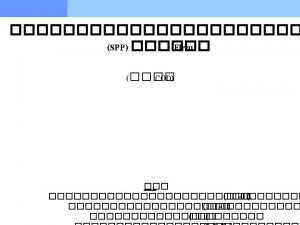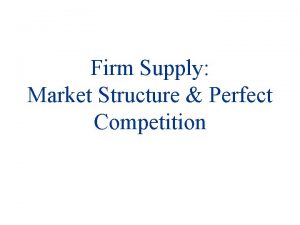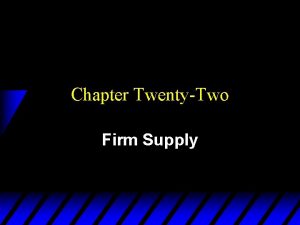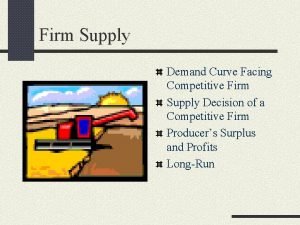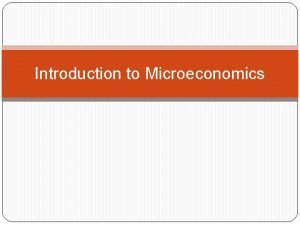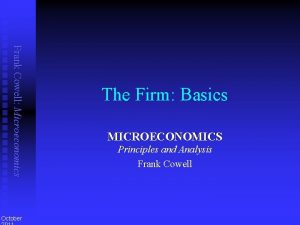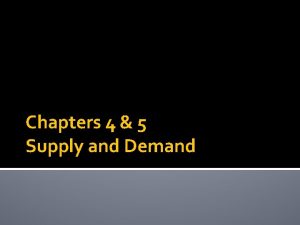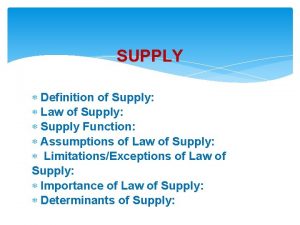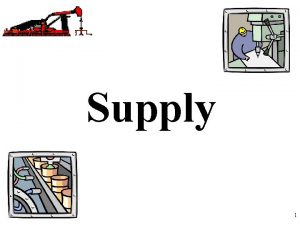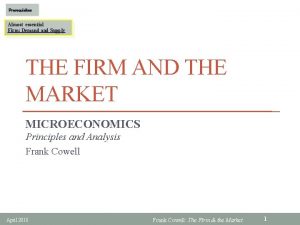ECO 365 Intermediate Microeconomics Lecture Notes Firm Supply































- Slides: 31

ECO 365 – Intermediate Microeconomics Lecture Notes

Firm Supply in Competitive Markets Market Environment: ways firms interact in making pricing and output decisions. Possibilities: (1) Perfect Competition (2) Monopoly (3) Oligopoly (4) Imperfect Competition (monopolistic) In P. C. p=fixed for the producer Why? => small firms, identical products, large number of firms Examples

Firms are price takers at market prices P S D market O OR P P* P* Don’t usually worry about p < p* since these firms are typically smaller and can’t produce much df D market y y

The firm’s problem is to max � = py - c(y) Is this a long run or a short run problem? ∆R = p ∆ y + ∆ p y => ∆R/ ∆y = p = MR But p = MR Why? ∆C/ ∆ y = MC Choose to produce where MR=MC Why does this make sense?

Exceptions to the Rule P P* mc A B Df Y A= point of � minimization Why? MC downward sloping => increasing y, decreasing mc => Decreasing C MR=> � increases as y increases B= point of � maximization

(1) any movement from A increases � (2) any movement from B decreases � Idea of second order conditions What does that mean? First order conditions : MR=MC Second order condtions: slope of MC > 0 Or slope of MC > Slope of MR = o => B is the correct point

2 nd Exception—Shut Down Short-Run: if shut down => lose fixed costs (F) When is this better than operating? = -F if y =0 � = py – Cv (y) – F � if y>0 So if –F > py – Cv(y) – F => shutdown or Cv(y) > py Or Cv(y)/(y) > p or p < AVC => shutdown Similarly in the Long Run: � = 0 if shutdown � = py – C(y) or p < AC

A= Short Run shut down point B = Long Run shut down point p AC AVC B A Y

MC $ LRAC A y ÞA = LR shut-down point Short Run Supply = portion of MC Above point A in 1 st graph Also LR Supply = portion of LRMC above LRAC loss minimization

Profit (graphically) MC AC p AVC P* Df Also Inverse Supply 2 Choices: y* y (1) Ps = S (y) (2) y= S (P)

Profit = the shaded area in the graph =p*y* - AC(y*) y* TR TC Since AC(y*) = TC(y*)/y* Now more carefully define producer surplus. Recall: p Producer surplus S P* y* Y

MC p AC AC P* AVC y* P* Y Producer Surplus = the shaded area in the graph Why are the two graphs equivalent? AVC y* Y

Why is Producer’s Surplus relevant if profit matters? In SR must be true that ∆PS=∆� Why? Fixed costs don’t change as y changes in SR L-R Supply Curve S-R Supply Curve = MC above AVC Where MR=MC P= MC (y, k) – k is fixed L-R Supply Curve = same with K variable => where MR = MC P = MC (y, k(y)) K is optimal

In L-R � > 0 or Py – C(y) > 0 Or p > c(y)/y or P > ATC Lmc $ LR Supply Constant Returns to Scale L atc $ Cmin L atc = Lmc y What is LR Supply? y

Relationship between long-run and short-run supply curve for a given firm is given by: p SSR SLR Y 1 Y

Why would SLR be more elastic (more responsive to price changes)? Can change both K & L optimally in the L-R => Increase y at lower cost beyond y 1 in the LR Note: (Producer Surplus)LR = �LR since all inputs are variable.

In the short-run, firms can be found with 3 different situations where y > 0. MC AC AVC p P* Df y* 1) π > 0, y > 0 y MC AC AVC p Df P* y* 2) π = 0, y > 0 y

p MC AC AVC P* Df y* y 3) π < 0, y > 0; why is y>0? What is the short-run industry supply? S = Σ Si (P) = Σ MCi for all i firms. Recall that firm short-run supply = firm’s MC curve above AVC.

Long-Run Equilibrium in Perfect Competition No fixed inputs. Free entry and exit. Consider firms of type 3 above ( π < 0 but p > AVC) who still produce in short-run. What happens? No fixed costs => observe exit in the market and π rises to zero. Consider firms of type 1 above (π > 0). What happens? The positive π serves as a signal to other firms to enter => π falls to zero. The long equilibrium occurs where π equals 0. What does this look like, assuming all firms have the same costs?

MC LRAC=AVC p P* Df y* y Notice that y* must occur where LRAC is at its minimum. Why? Also p* = C(y*) => π = 0.

What does LR industry supply curve look like if firms are large relative to the market? Assume that all firms are the same => industry supply in SR = Σ MCi = n. MC; where i=n (i. e. , n = the total number of firms. Suppose that there are 4 possible firms then get: p S 1 S 2 S 3 S 4 P* D 1 Y

p S 1 S 2 S 3 S 4 P 1 P* D 2 D 1 Y 2 Y Notice that equilibrium p and y is given by the lowest possible price where p 1 ≥ p* and y* is at that intersection. Thus, if D = D 1 then p = p 1 and Y = Y 1 If D = D 2 the p = p 1 and Y = Y 2

With large plants then long-run supply looks like: p S 1 S 2 S 3 S 4 P* Y P* = the minimum LRAC. The above is with only 4 firms total.

What if firms are all very small with respect to the market? p P* SLR = min LRAC Y

Taxes The graph below shows the SLR both before and after a tax is imposed. p P*+ tax P* SLR after tax SLR before tax Y

Where is the equilibrium? For that must have Demand SSR p P*+ tax P 1 P* SSR SLR after tax SLR before tax D Y Short-run Equilibrium is at P 1 therefore, both firms and consumers pay tax. Long-run Equilibrium is at P* + tax therefore only consumers pay tax in long-run.

Before assumed that costs were constant with entry. Is that a reasonable assumption? p P* p SLR = min LRAC Y Increasing costs with entry P* SLR = min LRAC Y Decreasing costs with entry

Economic Rent Suppose that we look at the rent earned by a highly paid sports or entertainment individual. Do D and S still determine price? Yes. p S P* D Y

D and S still determine price but what economic rent is the player getting? That is, due to a talent restriction, there is no free entry for the players. Can profit be driven to zero under these conditions? Suppose fixed supply of Peyton Manning and his opportunity cost = $100, 000 but his MP in football = $10 m. Profits are driven to zero just for the firm producing the product (i. e. , NFL team). The economic rent is the payment for the fixed factor(s) = total fixed costs. What is rent seeking behavior?

What affects the size of the rent? Depends upon the fixed supply for the talent market (Peyton Manning) and the no-talent market (me). p S P* D D Y Talent Market Y No. Talent Market

Final notes on Perfect Competion Assume that we generally having an increasing cost industry with an upward sloping long-run industry supply. This leads to an equilibrium that is allocatively efficient. One that maximizes net surplus (i. e. , MSB = MSC or no deadweight losses). p S=MSC P* D=MSB Y* Y
 Intermediate microeconomics lecture notes
Intermediate microeconomics lecture notes Intermediate microeconomics notes
Intermediate microeconomics notes 01:640:244 lecture notes - lecture 15: plat, idah, farad
01:640:244 lecture notes - lecture 15: plat, idah, farad Secuencia eco gradiente
Secuencia eco gradiente Switch mode power supply lecture notes
Switch mode power supply lecture notes Short run graph
Short run graph Short run supply curve for a perfectly competitive firm
Short run supply curve for a perfectly competitive firm Lrac curve
Lrac curve Enterprise vault migration to office 365 bittitan
Enterprise vault migration to office 365 bittitan Project procurement management lecture notes
Project procurement management lecture notes Theology proper lecture notes
Theology proper lecture notes Public sector accounting pdf notes
Public sector accounting pdf notes Project management lecture
Project management lecture Electricity and magnetism lecture notes
Electricity and magnetism lecture notes Classical mechanics
Classical mechanics Physical science lecture notes
Physical science lecture notes Power system dynamics and stability lecture notes
Power system dynamics and stability lecture notes Microbial physiology notes
Microbial physiology notes Introduction to mechatronics ppt
Introduction to mechatronics ppt Limits fits and tolerances
Limits fits and tolerances Financial engineering notes
Financial engineering notes Bipolar junction transistor notes
Bipolar junction transistor notes Requirement analysis in software engineering notes
Requirement analysis in software engineering notes Ofdm lecture notes
Ofdm lecture notes Land use planning lecture notes
Land use planning lecture notes Project quality management lecture notes
Project quality management lecture notes Lecture notes on homiletics
Lecture notes on homiletics Foundation engineering lecture notes
Foundation engineering lecture notes Image processing lecture notes
Image processing lecture notes Cloud computing lecture
Cloud computing lecture Decision theory lecture notes
Decision theory lecture notes Polynomial regression least squares
Polynomial regression least squares

